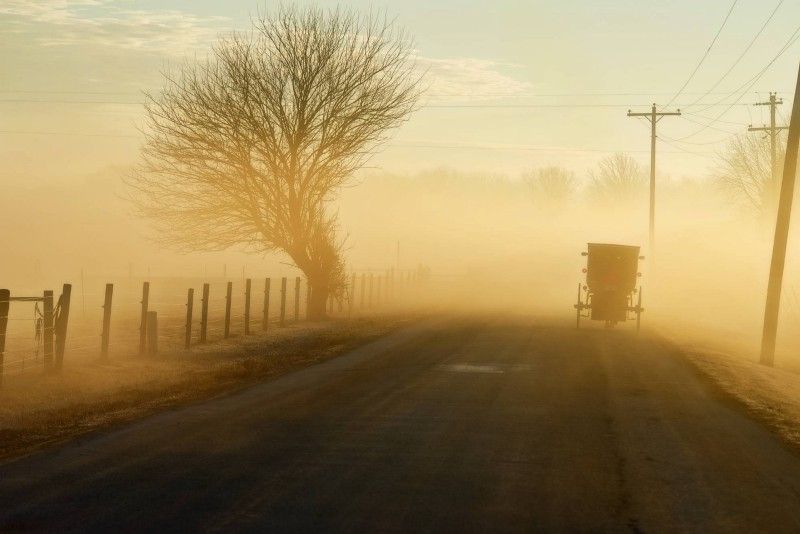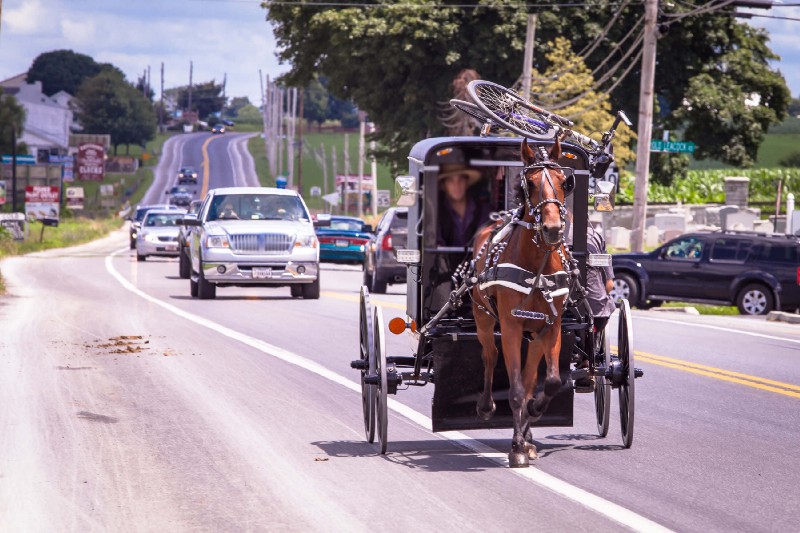A Life off the Grid
I am in the shower, standing under the hot rain and waiting for the next great idea. The shower thoughts do not come. I can only think about the washcloth being a Velcro mat for body hair. Is this the best we can do?

A Weekend with the Amish
I am in the shower, standing under the hot rain and waiting for the next great idea. The shower thoughts do not come. I can only think about the washcloth being a Velcro mat for body hair. Is this the best we can do?
Speaking of hair, my wife is blow drying hers at the sink. I tell her I’d like to talk about some poetry I’ve recently written, about our love being like a bird.
My love for you is like a bird, up in the sky. The higher I go,
I hear the door slam as she walks out.
Dressed, we all make our way out into the car, my wife and I and two kids, with a large suitcase and snacks and drinks and DVDs, to head West for a long weekend in the land of the Amish. Sweet butter, pies, horse-drawn carriages, men with beards but no mustaches, and lifestyle nix on modernity. Families scorn electronics and appliances. A land where time stopped before the industrial age took hold. I’m looking forward to technology free nights at the Strasburg, Ohio Ramada Inn.
The highway quickly turns from the shopping plazas and wall to wall gas stations north of Pittsburgh into verdant rolling hills dotted with farms and mega-churches. We briefly skim through West Virginia before crossing the inspirational Veteran’s Memorial Bridge in Steubenville, Ohio.
On we glide, a hunk of metal drawn to the magnetism of the Amish. We pass the scar of pipeline construction that crosses the Cadiz-Steubenville Road between Bloomingdale and Hopedale. That worm begins at the Kensington Process Plant and ends at Sunfish Creek State Forest, a feat of amazing engineering and policy. How much money is being pulled out of the ground? It reminds me of the underground pipeline in Florida that sends Simply Orange juice through tubes 1.2 miles from a mixing facility to a packaging plant. I wonder if the Amish are right, that some technologies are better left untouched.
Finally, we see an Amish buggy on the road, which draws squeals of delight from the kids. It is driven by a teenage boy wearing a sweatshirt. He is a Buick Impala shy of the Rumspringa. The kids want to know where his beard is and where the horses poop.
Our first stop in Amish country is a recommended destination stop on the side of the road. My wife and I fight because I miss the turnoff which she insists she clearly mentioned. I respond that thinking about a turn is not the same as talking about it. We’re off to a good start after only two hours in the car together.
We pull up to a huge metal building that hosts an “Antiques” sign on the front wall. There is a buggy ride and an old Amish house tour and a field with a miniature horse.
We hop out of the car in excitement but soon feel taken. The miniature horse has bad back legs and can’t hobble over to be petted. The outbuilding houses a puppy mill, with yowling whelps biting ponytails and the ears of little kids lain down on the floor with them. Their air is oppressed by heavy sorrow and I can’t wait to find the exit.
The main building is full of regular things people just don’t want any more. I find a box with sandwich bags full of broken wristwatches. Aisles are piled high with loads of unwanted furniture for sale, clogged with tourists waddling through, picking at things.
What’s so Amish about bins of junk jewelry and rusty gas station signs?
We head off for the Amish house tour. This consists of a woman unlocking the front door of the house and letting us in. “Enjoy the tour,” she says as she steps aside for us to step in to look around. Ah, self-guided. But the host is nice and hangs by the entrance to patiently answer questions, especially eager to explain that none other than John Dillinger himself had a connection to this house. But John Dillinger, her highlight: not Amish.
The home’s walls are hung with typed stories explaining Amish weddings, Amish clothing, and Amish adolescence. It looks like a regular house. Nicer than my house. Just no TV.
In the main sitting room, the furniture wraps around a noble desk, upon which sits an open Bible. A child’s room has one toy — a doll with no face. A closet of clothes allows for pales shades of blue or whites; no patterns or embellishments. Old order Amish do not allow buttons, they use hook and loop. The house does not have modern running water. Instead, a pump from a well runs straight up through the floor and into the huge farmhouse kitchen sink. Clever.
Next, the buggy tour takes us through the parking lot, down by the “barn” that is really a non-Amish theater advertising an evening family comedy show (we know it is wholesome because the farmer in overalls on the poster smiles through crossed eyes and bucked teeth, recalling mid-century gags) and back up around to the puppy mill. My kids grumble.
At least the buggy driver was, in fact, Amish. I tried to talk with him but realized we did not exactly speak the same language. He spent five minutes using his hands to explain how when a horse bites, it can’t let go. “That’s horse!” was how he ended it as he shrugged and turned away. Indeed, old man. That’s horse.

Back out on the road, having learned our lesson, we skip past the next two towns loaded with tour buses and shoppes selling syrup with rows of people lined up for cheese samples and still more barns full of antiques, as though central Ohio was the clogged tub drain of all of America’s unwanted old furniture.
We made any turn we could to break away from the main roads, driving in wide loops through the countryside, my wife and I singing the few words we could remember to “Fifteen Miles on the Erie Canal,” over and over again, while the kids in permanent eye-roll mode look out the window, embarrassed of us before nature and the farm animals, we crest a hill to suddenly see a market off a dirt beaten road.
In the market parking lot, an Amish fellow was hefting his wife onto their tractor, a bag of goods in her hand and baby slung over her back. The tractor shook to life, a bail of hay still speared to the front forks, stopped mid-work for a run to the store, and off they rattled, the wife and baby hanging from the side.
“This is where I want to shop,” my wife and I harmonized.
Inside, we sampled jams and candies and smoked meats and loaded up a cart with everything, part as novelty and part to satiate our previously tempered need to shoppe.
Two Amish girls stood in a section of the store idling time, no doubt catching up on the latest news. But I couldn’t eavesdrop because they were speaking in German.
Other women in head coverings scooped ice cream or refilled the bins of free dip or swept the floors. White bonnets and pale-colored floor-length skirts busied the shop from end to end. No men worked in the store, save for one teen boy by the front door. A form of security, I’d wager.
I did not see many Amish men. It was mostly women and they were mostly in the stores or out cutting grass. Their lawns are immaculate, by the way, cut by the women in their long stiff dresses who heave forward behind huge mowers.
I figure the men are all out working the fields, away from the commercial hustle, living meaningful lives filled with the satisfaction of labor and self-sufficiency. They were maybe cutting wood or plowing the earth with some impossibly ancient steel blade. I was told they pay a self-elected road tax of fifty dollars a year, to account for their use of the blacktop by horse and buggy. That’s pride in place.
The Amish live off the grid, but apparently with some high degree of comfort and gratification. Their large dark blue or white country houses are topped with beautiful black metal roofs and many have solar panels. Solid bolts of clothing hang to dry on sweeping lines, trying to take flight in the wind. Buggies are maintained to a fine matte polish, horses brushed, and boots wiped clean. The teenage boys I did see had their necks shorn fresh and hairlines trimmed straight. There were dozens of Amish riding bikes.
Word was that the solar panels powered washing machines and maybe a refrigerator. But these Amish otherwise farm, sew, herd, and travel without electricity from the power line. You have to wonder how much longer they would survive after the rest of us die if the power grid went down. After all, Millennials are thought to be the force behind the decline in the use of bar soap because it is “inconvenient to use.” We are not a rugged people, by comparison, are we?
At night we take a walking ghost tour of Zoar, Ohio. In the dark, led by an older gentleman wearing settler’s garb (a shirt with no collar and wool vest), we walk the streets, from building to building, hearing ghost stories at each stop.
A woman, holding a candle to her face for illumination and effect, tells us that one cold night she was alone in the boarding house, sweeping the hallways, and when she turned back around, all her swept dust piles were gone. She holds a pregnant silence for dramatic tension. My children giggle.
Inside an old and decrepit hotel, our host was posing for a photograph with a tourist and I asked him, “Do you want to wait for that gentleman behind you to move?” When he turned, there was no one there. He paused as if shaken. My wife punched my arm.
There were no headless horsemen or Indian spirit raiders, only slamming doors and a chair that once rocked on its own. And disappearing piles of dust. We drove on through the night to our hotel laughing at the timidity of the specters, but I admit I could not shake a chill that had come over my body, deep into my bones.
In 1834, over a hundred residents died of cholera in Zoar, Ohio. If their unhappy ghosts still roam that tiny town, how many more crowd around the living rooms and shops of the greater cities where hundreds of thousands more have perished to untimely causes?
We never do enjoy our technology-free nights. There are nationally televised college football games each evening, and we submit to them, laying on the hard hotel mattresses, chewing jerky and fighting over the last whoopie pie.
I’m sure that somewhere that weekend, an Amish family sat around a desk with an open Bible on it, and after evening prayers, before boiling their clothes in potato water or whatever they do to make their clothes so stiff, they talked about the weak family in the minivan, whose kids watched movies in the back row while the chubby dad drank armfuls of coffee and salted almonds and mom looked into her phone, frantically waving arms about missed turn-offs.
I’d bet they get a good laugh out of it all, knowing that the rest of us, so self-important, will wither and die off the vine at the slightest breeze of winter while they, the Amish, carry on, mowing, and digging, and surviving.
